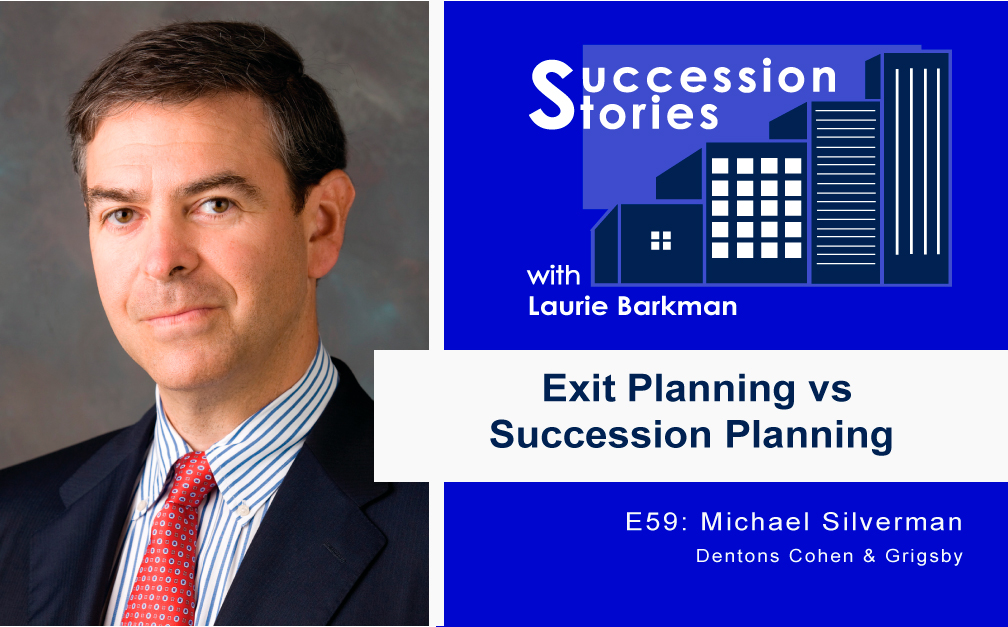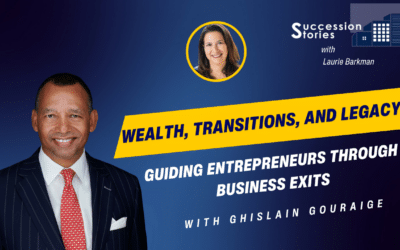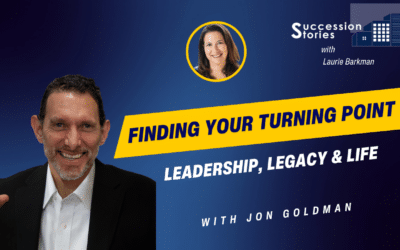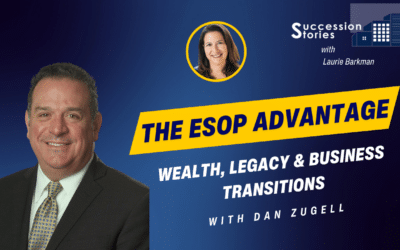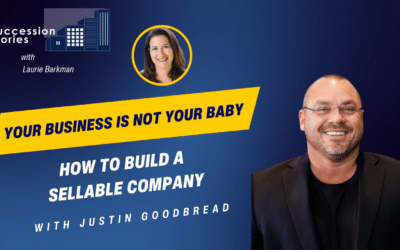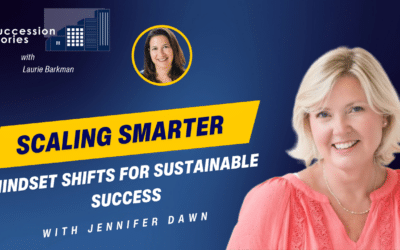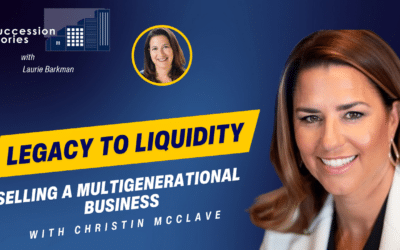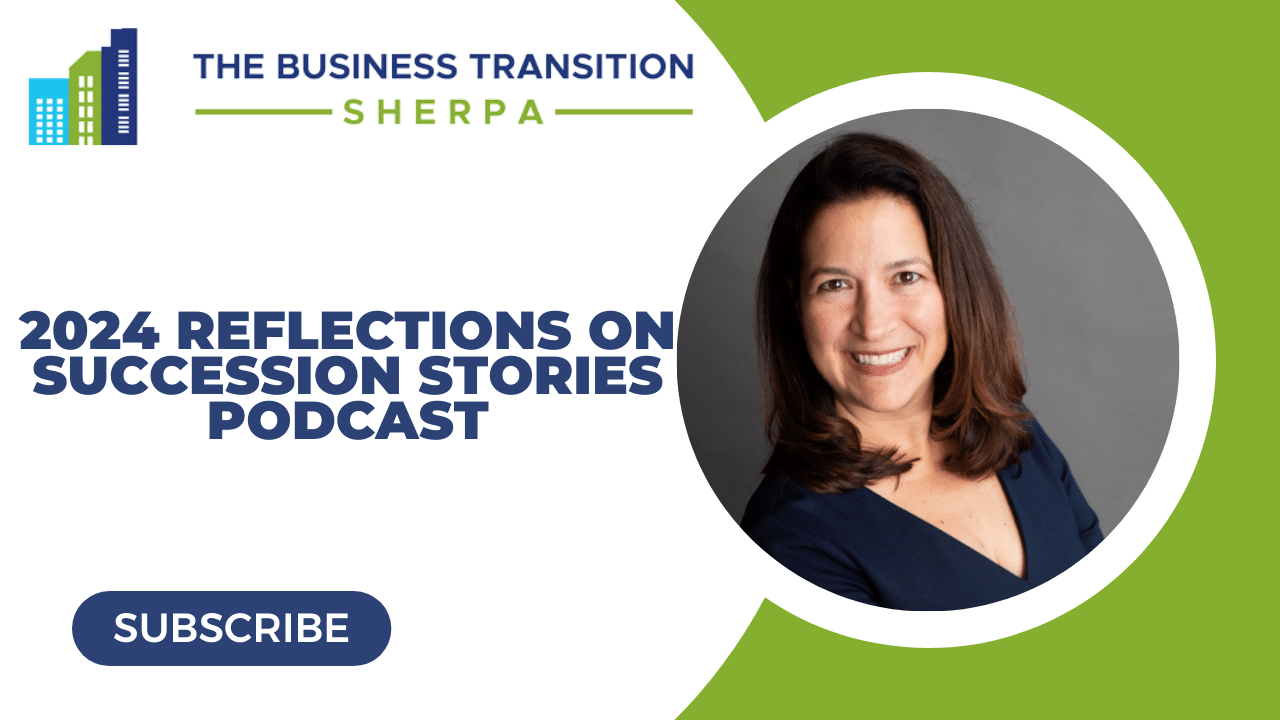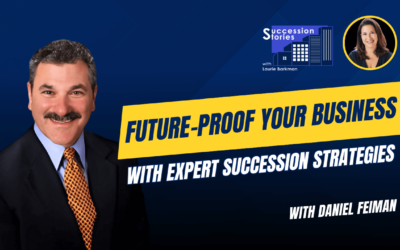How does exit planning differ from succession planning for business owners? Laurie Barkman and Mike Silverman, Shareholder of Dentons Cohen & Grigsby, discuss the strategic benefits of business transition planning to maximize enterprise value and exit options. Listen in to learn more about the differences between exit and succession planning and importance for your business. Be sure to learn more about the Business Advisory Group– a collaborative approach to exit and succession planning for business owners– and how they can help you get started.
Stream the episode
Listen in to learn more about:
- The difference between an Exit Plan and a Succession Plan
- Why it’s important to design and implement these plans as a business owner
- The strategic benefits of internal transactions
- The pros and cons of different exit options
- The financial implications of your succession and exit strategies
Watch the interview video
Show Links:
Contact Michael Silverman: msilverman@CohenLaw.com
Clearing Blurred Lines of Business Transition with Chris Chaney, Succession Stories E22
Maximizing Value: The Key to Your Business Exit – Webinar Replay Video
The Succession Stories podcast is hosted by Laurie Barkman, Business Transition and M&A Advisor/Founder of SmallDotBig, a strategic advisory firm for closely held businesses anticipating a leadership or ownership transition in the future.
Episode Transcript
Laurie Barkman:
Mike Silverman is a Shareholder of Dentons Cohen & Grigsby, representing closely held businesses and their owners throughout their lifecycle. Entrepreneurs don’t start and build their companies on their own, and neither should they plan their business transition or exit strategy without trusted professionals in their corner. We’ve put that shared philosophy into practice, with a collaborative initiative called the Business Advisory Group, that also includes Chris Chaney from Fort Pitt Capital Group, to educate business owners about exit value planning. You might recall Chris was a featured guest on Episode 22. Listen in to my conversation with Mike to learn more about the difference between an Exit Plan and a Succession Plan, why it’s important to design and implement these plans now, and the strategic benefits of internal transactions.
Laurie Barkman:
Mike Silverman, good morning. Thanks for joining me today on Succession Stories.
Michael Silverman:
Good morning. Thanks for having me.
Laurie Barkman:
I’m glad that you’re here with me. I also want to point out that I think it’s really cool how we met. We met because of the show, we met because of Chris Chaney who was a guest on the show, Episode 22. He and I had a fantastic conversation about business transition, which led him to introducing you and me and which brings us here today to continue that conversation and talk about business transitions. Also, you, me and Chris and his firm Fort Pitt Capital Group, are forming a collaboration that we’re calling the Business Advisory Group, so I’m excited to have you on today to talk about exit and succession planning, and also for us to share with the audience how we’re looking to educate business owners about business succession and transition planning. Welcome.
Michael Silverman:
Thank you. I’m happy to be here.
Laurie Barkman:
Why don’t we start with you? Why don’t you tell us about you, what you do at Dentons, which is the largest law firm in the world, by the way, which is super cool.
Michael Silverman:
I’m a partner at Dentons Cohen & Grigsby. I’ve practiced law now for 31 years and last year, my firm, which was formerly known as Cohen & Grigsby, aligned itself with Dentons, which, as you indicated, is the largest law firm in the world. We have offices throughout the world and throughout the country and so we have boots on the ground for wherever the client needs us.
My particular practice is that of a business attorney, I represent closely held businesses and their owners throughout the lifecycle of a business, I help them to grow, I help them to attract employees, acquire other businesses, and ultimately, to exit from their businesses and exit. Succession planning is a big part of my practice. I got certified as a certified exit planning advisor in 2010 and throughout my career, I’ve done probably over 150 exit plans and I’m very passionate about the area. It’s an area where I feel that I can add a lot of value to my clients, and so I’m very happy to be talking about it today.
Laurie Barkman:
You’re an incredible expert. Tell me, why are you so passionate about it?
Michael Silverman:
I’m passionate about it because I think with the exit planning process, it’s more than just structuring your exit plan instruction, your succession plan, it’s really looking at your business from the outside-in which, business owners go 100 miles an hour every day in their businesses, and they don’t have time to do that and so it forces them to pause, look at their business from the outside-in, find all the valuable ingredients in there, make sure that they’re protected, and make sure that we’ve identified any great value drivers that we can employ in the future. I think that above and beyond just putting in place a great exit and succession plan for a client, you can add a lot of value, help them to grow the value of their business and help them to realize a significant exit when they exit from that business.
Laurie Barkman:
I love how you describe that. I think that’s the main reason why you and I clicked so instantly. We share the same philosophy and ethos with my practice. That’s what I love to do also so I love our collaboration that we’ve started. Why don’t we talk a little bit about exit planning and succession planning? What do you see as the differences between the two?
Michael Silverman:
I think a lot of people view them as being redundant with one another, and they’re entirely separate from one another. The exit plan is obviously the structure and plan by which an owner is going to exit from his or her business. So whether the owner wants to sell the business to a third party, sell the business to a management team, or pass the business down to his or her family, we need to come up with an exit plan that’s tax efficient, and that will hold up both a voluntary exit or an involuntary exit. A succession plan is completely different. A succession plan is identifying who the key employees are in the business, which are typically the owner and a few key other employees and figuring out who’s going to succeed them in operating the business in the future. Because we want to have a seamless transition not only for our exit from the business, but from our succession as to the leadership that’s going to be running the business in the future.
Laurie Barkman:
Why do you think, also, that it’s important to start planning sooner rather than later? Because I know a lot of people that I talk to, they’ll say, “Oh, you know, I’m not thinking about that for another 10 plus years. That’s for someone else, right? It’s sort of not me, I’m gonna do that later. I’m going to do that in the future.” Then there’s other people that are in this middle space that are like, “Oh, I don’t know if I should be doing that,” and then there’s the people that are, “Oh, crap. I want to be exiting my business, but I haven’t been working on this, and now now what do I do?” So how do you approach that? How do you advise people about timing?
Michael Silverman:
Well, every new business that I get as a client, I would say almost without exception, they haven’t done their exit and succession plan so it’s a rhetorical question to ask them whether they’ve done it. It’s like asking whether they’ve done their estate plan. People procrastinate on it. But what I highlight for every business owner is you as a business owner are one day going to either voluntarily or involuntarily exit from your business, and during the course of my career, I’ve had a lot of involuntary exits, it’s everything from death, or disability of the owner, a key employee, to losing a key employee, or losing a key customer or losing a key vendor. So those involuntary events, those could happen tomorrow. So that means we need just like your estate plan could come into vogue tomorrow, your exit succession plan, we need to plan for that involuntary event so that we don’t have a fire sale of your business as a result of having not planned for it.
Laurie Barkman:
Some people might call that contingency planning too, where it’s this worst case scenario planning, as you were saying, and I think we refer to that, generally as the five DS – it could be divorce, even sometimes that is a factor of why a business owner might might leave the business insurance or be another tool, correct?
Michael Silverman:
Right. I think that when we get into the nitty gritty with exit succession planning, we really are doing very holistic planning. It’s not just a lawyer, or just an accountant or financial planner, or coach, it’s a team that puts it together, and so you have everything from contingency planning, which is life insurance, planning, and Disability Insurance planning, to growth planning – if you’re not growing your business, you’re exiting from it. So in financial planning, we need to know, what is the number that you need for retirement? And how does that mesh with your biggest asset where you have probably 90% of your net worth is embedded in the value of your business? How much can you realize from selling your business? And how does that match up with the number you need for retirement? And then there’s usually a delta between those numbers, and we need to do growth planning to eliminate that delta so that’s obviously where you come into play.
Laurie Barkman:
Exactly, and I think that that’s super important, because that delta, I’m guessing, more often than not, is what you see.
Michael Silverman:
Oh, yeah, for sure. Because I want to, on day one of doing exit and succession planning, put in the bright lights for a business owner, two reference points. I want the financial planner to tell the client, “This is what you need for retirement,” and then I want to do a back of the envelope valuation of the business and say, “This is the gross value of your business, but after taxes and professional fees, if you sold your business, this is the net number you get, and look at this difference between these two numbers, what your financial planner gave you and what you could net if you sold the business today. Does that motivate you to want to eliminate that delta so that we’re on a good course?” That’s what we do at the outset.
Laurie Barkman:
I think it’s also important to spotlight that not only are we trying to get the business ready for a transition or an exit, but also I think the personal readiness side is important, and this process of going through it understanding why these steps should be taken helps someone emotionally get to that point. Is that what you find also?
Michael Silverman:
I find that is definitely the case. Because with every client, you want to extract from them, “What are your business goals, your financial goals and your personal goals?” The personal goals play a big factor in it and if we don’t implement a really well conceived exit and succession plan, that can prevent you from obtaining your personal goals where your financial goals or business goals.
Laurie Barkman:
Yeah, and some people might want to buy another business and keep going or some people might want to start a company and some people might say, “I want to punch out, I want to do something completely different. I want to go sailing,” and so I just want to underscore what you said about the financial plan because they need to know what number it is. So if they’re planning to retire at 55 but yet they think they’re gonna live till 95 they’ve got 40 plus years to plan for so there could be that gap and the lifestyle they want to live, the wealth that they think they need, as well as all part of that.
Let’s talk a little bit about who business owners should work with. You and I have a very collaborative approach and so does Chris Chaney and that’s, again, how he brought us together for a business advisory group that we’re forming. This collaboration inherently…I’m a growth advisor, exit value planner, someone that’s going to try to help close that gap on the value and, yourself and Chris on the financial side. That’s a great example, I think, of showing and demonstrating a collaborative effort on behalf of the business owner. We share that philosophy. What is the approach that you’ve seen when you know what can go wrong if a business owner does not have a group of trusted advisors with experience in these areas?
Michael Silverman:
I see a common theme in this context. First of all, the typical business owner has professional advisors; a person that does what you do, what I do as a lawyer, has a good accountant, has a good financial planner. The problem with… I mean, it’s great to have very good professional advisors. The problem is, those people have two things holding them back from properly representing the client in this context with exit and succession planning. Number one, they tend to not be proactive since they don’t have a background or experience with doing exit and succession planning. They can’t be proactive with the client, and tell the client, “It’s critically important for you to get this planning done, and here’s what happens if you don’t.”
Second of all, they don’t coordinate with each other. They each operate in a vacuum and exit and succession planning requires extreme coordination between those professional advisors. They have to very thoughtfully go through their respective disciplines and come up with a really good exit/succession plan that they’ve thought through and agreed upon. Lastly, there are not many professionals that are certified exit planning advisors, or that have significant experience with doing this. It’s a real niche area. There are lots of business lawyers, lots of accountants, etc. but you really have to have done many, many dozens of plans, so that when you see a particular fact pattern, you can really articulate a lot of good options for the client so that’s what I typically see. I first learn from the client, they haven’t done it, second of all, learn from the client, they don’t know what it means. They don’t know the difference between the exit plan and succession plan and then third, they want to hear about why it’s important. Lastly, I think they probably call them professional advisors and say, “Why didn’t you tell me about this?”
Laurie Barkman:
I’ve seen that too, where they’ll say, “I have an accountant,” and I’ll say, “Do they have experience in this?” And they’ll say, “Oh, no.” They’ve had that friend who’s a personal attorney, or a business attorney for years but they’re doing employment agreements, or smaller matters. The other thing that you mentioned, I want to circle back to is creating options. I think that’s a really important point, because some people might want to pass the business to a family member. That can certainly be part of succession. I know you and I are talking about exit and people probably think, “That’s the sense of negative exit; I’m going to exit my business.” I think exit really, to me means having options as well as succession because it could be to a third party, it could be to management, and let’s talk about that. Let’s talk about the different types of options. We’ll talk about the pros and cons. Let’s start with the most common one, which is, what are the pros and cons of selling to a third party.
Michael Silverman:
I think a lot of my clients have a misconception that it’s Nirvana to sell your business to a third party buyer. I think that the big pro to selling to a third party buyer is oftentimes an investment banker can align you with a strategic buyer, that’s going to pay you a lot higher price than current fair market value. So that’s probably the biggest pro of selling to a third party buyer. The cons are several fold and I always walk this through with the client during exit planning. Because first of all, you have professional fees, which aren’t inconsequential either. You have legal fees, accounting fees, and other professional fees involved with completing a transaction, those could be significant six figure fees. Secondly, most importantly, you have liability. Because when you sign a purchase agreement, you’re making probably 25 different reps, representations and warranties about the business. And there’s a very elaborate indemnification section in that agreement, where the buyer can come back to you for a pretty lengthy period of time after the closing, to come after you for up to 100% of the purchase price.
It’s not like you complete your closing and you walk away and sleep real well at night. You have factors at work there. The other thing that happens with third party sales that really burns me up is that a lot of times the purchase price isn’t paid cash on the barrelhead at closing. A lot of times you’ll get a promissory note, a lot of times you’ll get what’s called an earnout which is a contingent purchase price. So a lot of times you don’t end up getting 100% of your purchase price for a variety of reasons. The note doesn’t get paid, you don’t realize the contingent purchase price milestones etc. so there is a mini parade of horribles if you’re doing a third party sale.
Laurie Barkman:
Let’s talk about earnout. I think that that term is used generally and I know it can be defined tactically how it works quite differently. Can you just share a couple of examples?
Michael Silverman:
Sure. I just completed a transaction a couple of weeks ago where the total purchase price was $5 million. At closing, my client got $3 million, but $2 million of the purchase price is payable on a contingency basis over time. Basically, the business which is now being run by the buyer has to hit certain revenue targets on an annual basis for that additional $2 million to be paid out. So if the buyer doesn’t run the business well or for whatever reasons, the business doesn’t produce those revenue targets. My client doesn’t get that $2 million of additional purchase price.
Laurie Barkman:
Sometimes it’s on profitability, correct?
Michael Silverman:
Sometimes it’s on your cash flow or your net income or profitability as you indicated. It can be on a variety of factors, it can even go as far as to retention of customers, retention of employees, sometimes there’s multiple components of a milestone, so you can get pretty elaborate.
Laurie Barkman:
Now, who tends to drive that. Do you find that it’s a negotiation back and forth, or is there typically one side really driving?
Michael Silverman:
It’s the buyer that drives it and usually if you think about it, your purchase agreement is a report card for the exit and succession planning you’ve done. So when I have an earnout in my purchase price, it means I haven’t done the exit plan, because there won’t be an earnout if I’ve done your exit plan and so really, what the buyer is concerned about is that the business is dependent too much on the owner being there, on a critical customer, on a particular vendor, you have some type of concentration issue that’s giving the buyer pause and they’re saying, “I want it, I’m not gonna pay you 100 cents on the dollar closing, I want to make sure everything goes according to plan over the next three years,” and that’s what we eliminated doing our exit and succession plan. We don’t want a haircut in our purchase price at the close.
Laurie Barkman:
Exactly. That’s one of the things that I look for in my practice with SmallDotBig is, there’s eight core drivers of value, one of which is can that business survive without its founder, its owner and just like you’re saying there, there’s all kinds of risks to the buyer if that’s not the case. So it makes sense that we don’t want an earnout and what can we do to help prevent that, so the good work that we’re doing to help make this business able to thrive – a sustainable business without its owner – because we have a good team around us, because we have processes in place, or technologies that can help be more us be more efficient, more effective, and the data analytics to support it, all of those things go into that.
Michael Silverman:
What I do highlight on day one of doing an exit plan for the owner, there’s a difference between value of a business and transferable value and what I highlight is if that if the business is dependent on you, because you’re tied to 70% of the customers, then that’s not transferable value. They’ll give you a consulting agreement for that 70% of the value of your business so we need to eliminate that dependency on you so the business can run equally well with or without you present. If we get there, then you have transferable value, and you’ll get 100 cents on the dollar closer.
Laurie Barkman:
So some other examples of structures and exit plans. Let’s talk about some other options. What’s another option?
Michael Silverman:
Another option, I think, some of the most common options would be that the owner wants to either sell or gift or bequest the business to his or her family but I’d say the most common or most popular structure is to transfer the business. The owner tends to be very loyal to the management team, the management team doesn’t have the deep pockets to drive a purchase to make a direct purchase of the stock from the owner so we do what I refer to as an indirect acquisition. What I mean by that is, I just simply go through two steps. I say to the owner, “We’re going to grant a small percentage of the stock in the company to the key employees and put them on a very long term vesting schedule.” So that in essence, they are extremely motivated to grow the value of the business and to see you exit from the business. The first step is, we grant maybe 5% of the value of the business to the key employees subject to a very long vesting schedule, maybe 10 years. Then we have a shareholder agreement between the key employees and the owner that says that overtime, the owner has the right to require the company to buy his or her shares. So as those shares are being purchased by the company, the shareholders who they’re not paying, any key employees are not paying any money for those shares. They’re just contributing sweat equity to the business, to create cash flow to buy out the owner so as the owner gets redeemed or purchased by the company, the key employees go from owning 5% to 20%, eventually 100%. They’re extremely motivated to be able to acquire a company without $1 out of their pocket and the owner is similarly happy because he gets to transition the business to his or her key employees and they’re motivated to generate the cash flow to buy him out and we eliminate all those cons that I described for you of a third party sale. We don’t have big professional fees anymore. We don’t have indemnification liabilities, employees, we don’t have uncertainty as a purchase price, we’re going to get 100 cents on the dollar. So all those negatives of a third party sale are eliminated when we do that structure where to get the business in the key employees.
Laurie Barkman:
So let’s call that an internal transaction.
Michael Silverman:
Yeah, an internal transaction’s a good description for it.
Laurie Barkman:
Sometimes I refer to it as a management succession. I don’t know if that’s a term that you would use also.
Michael Silverman:
That’s a fair description of the two.
Laurie Barkman:
What I like about that is it’s getting to the heart of what’s important to the business owner, because their legacy matters. They care about how the employees do after the close. They’re going to walk away unless they have a halting agreement for a short period of time, which can vary, but let’s say it’s a year or less, and they care about it because especially if their name is on the door, I see that lot, and they want to know that it’s gonna be in a good place. They do care about its sustainability, they want it to live on, even if they’re not part of it. So if we know that up front, we know that that’s what they care about. We can help structure an exit and succession plan that meets all of those things and meets their financial goals, so I love that solution. Do you see that that is more or less common over the last 5-10 years?
Michael Silverman:
I would venture to say that 60% of my exit plans are that very structure, and maybe only 25% of them are third party sales, and then the balance or a smattering of transferring that shares to family members or to an ESOP or something along those lines.
Laurie Barkman:
That makes a lot of sense. You, me and Chris Chaney, as we mentioned, are doing a collaboration and one of the things that we are putting together is a webinar to help educate business owners about exit and transition planning, and succession planning. What does it mean? How does it work? What are some considerations to make sure that they are able to not only get that 100% on the dollar, but my mission is to try to get them a premium, what can we do to help them increase the value of their business as they get ready for the future transaction and be happy with what they’ve come up with? It’s too often that, thinking about some survey data that I’ve seen, business owners that are surveyed a year after a close answer that they’re not happy with that transaction, and so I think for us, we’re on a mission to change that trajectory. We want them to be happy about it, and I’m really excited about this webinar. For you, what are the main things that you’re looking forward to highlighting, and why should somebody tune in to it?
Michael Silverman:
Well, I think it’s a great opportunity to hear from experts who have different disciplinary areas altogether, and have unique strategies for exit planning that impart tremendous value to a business. I think that you can hear uniquely from each of the experts, how they do and what their perspectives are and then you can also see at work, how those different strategies all fit together and why you need those individual experts to be working together coordinating with each other on your plan.
Laurie Barkman:
It’s going to be a great event. I know not everybody’s going to be able to tune in live, of course, so I will have the Maximizing Value webinar video recording and the archive of our event on my website, on smalldotbig.com, and I will put that link in the show notes if people are interested in checking it out. If you’re interested in listening and tuning in, I really encourage you to do so. As we round out towards the end here of our discussion, I love to ask all of my guests if they have a favorite quote that they like to share.
Michael Silverman:
My favorite quote probably is “Yesterday is history, tomorrow is a mystery, today is a gift, and that’s why it’s called the present.”
Laurie Barkman:
I like that it’s a very positive attitude. I appreciate that. So if someone’s listening, and they want to get in touch with you, what’s the best way to connect?
Michael Silverman:
Either call me on my office phone number, which is 412-297-4937 or email me at msilverman@CohenLaw.com
Laurie Barkman:
Mike, you have a wealth of knowledge about this topic, and I’m so appreciative to be connected with you and collaborating with you. I encourage everyone to check out our webinar and if you’re interested in reaching out to Mike or me about exit and value planning, we look forward to speaking with you.
Mike, thank you again, so much for being here.
Michael Silverman:
Thank you very much.

